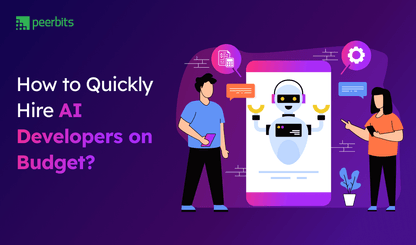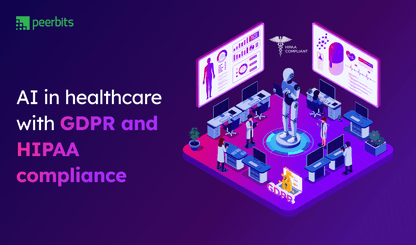Business teams are stretched thin. At the same time, customer expectations are climbing, and margins are tightening. Playing by the traditional playbook to hire more people, stack more tools, and build more layers is starting to break down now.
Businesses dealing with support teams are already drowning in repetitive requests. Operations are getting more complex, but the headcount hasn’t grown. Chasing growing demand with limited resources is not a solution anymore.
That squeeze is real—and it can't be avoided in this era of AI.
With AIs perfecting the tasks on every end, now customising the AIs based on your needs is the new approach. Even the global market for AI agents is gaining serious traction. According to Markets and Markets, the industry is projected to grow from USD 7.84 billion in 2025 to USD 52.62 billion by 2030, at a CAGR of 46.3%. That kind of growth points momentum.
As more businesses begin to explore AI agent services, they’re starting to see results that were not quite possible even a few years ago.
But, what is AI agent? Do they ease workload pressures?
Can they handle increasing customer demands?
And are they actually driving meaningful results without complicating workflows? Everything will be answered. So follow along.
What is an AI agent? And its growing popularity
An AI agent is an autonomous software system that can make decisions, take actions, and learn from feedback without needing step-by-step instructions each time. It uses a mix of context, real-time data, and goal-oriented logic to complete tasks.
This is not the old-school chatbot or a basic rule-based bot. Unlike traditional automation that follows fixed scripts, AI agents for business can adjust to changes, respond to intent, and improve over time.
Why is AI agent getting so much attention now?
What once felt distant is now part of daily operations.Have a quick look at how the AI agent market is moving:
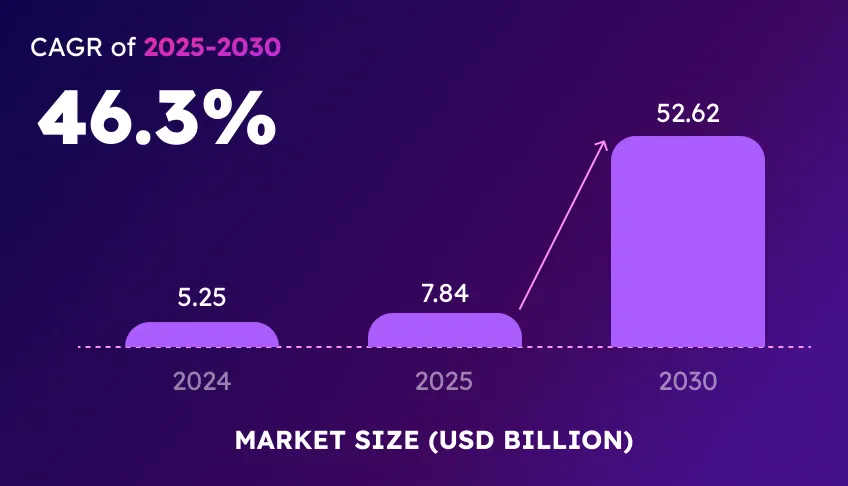
Well, it is a mix of factors. The arrival of stronger foundation models like GPT has changed what’s possible. Businesses are also under pressure to reduce operational costs, respond faster, and simplify workloads. And with more teams already experimenting with AI automation tools, adoption is growing faster than most expected.
How AI agents work?
AI agents handle tasks by cycling through three basic steps: Perception → Reasoning → Action.
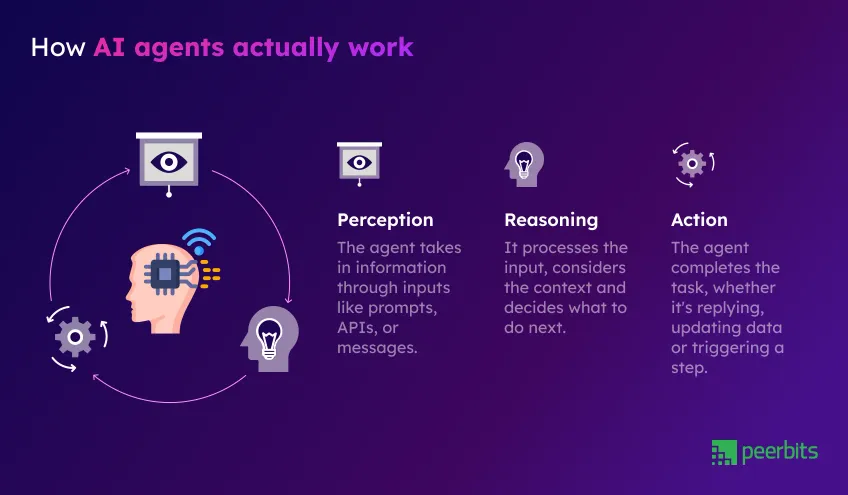
Perception:
AI agents begin by observing what's happening—whether it's a customer message, data update, or a task in a queue.
Reasoning:
The agent analyzes the situation, determining the goal and available options. Context is key here, such as identifying a support query or checking for existing data.
Action:
The agent then takes action—responding with information, updating records, fetching summaries, or escalating to a human when necessary.
What makes AI agents different from older tools is autonomy. You don’t have to script every single step. You give them a goal, and they decide how to get there based on the tools and data they have. This is what makes them valuable across use cases, especially for things like AI agents for customer service or operations teams trying to reduce manual handling.
Key components of an AI agent
You can think of an AI agent as a smart intern who never sleeps, understands your systems, and improves with every task. Like any good intern, it works in three core stages:
1. Input layer
This is how the agent “listens” or collects information. It could be through APIs, system alerts, customer chat messages, email threads, or internal data. These are its virtual sensors. It uses them to understand what’s going on.
2. Processing and decision-making
Once the input is in, the agent thinks. This is where machine learning, logic, and past feedback come together. The agent weighs context, interprets the task, and makes a decision—just like a smart intern who’s been trained on your ways of working.
3. Action or output
Now it’s time to get things done. The agent replies to a customer, updates a dashboard, sends an email, or completes a task inside your system. And if it’s uncertain? It flags it for review, just like a good intern would.
Together, these components are what make AI agents for business so effective. They are not just listening or automating, they’re thinking and acting, fast and quietly in the background.
Types of AI agents
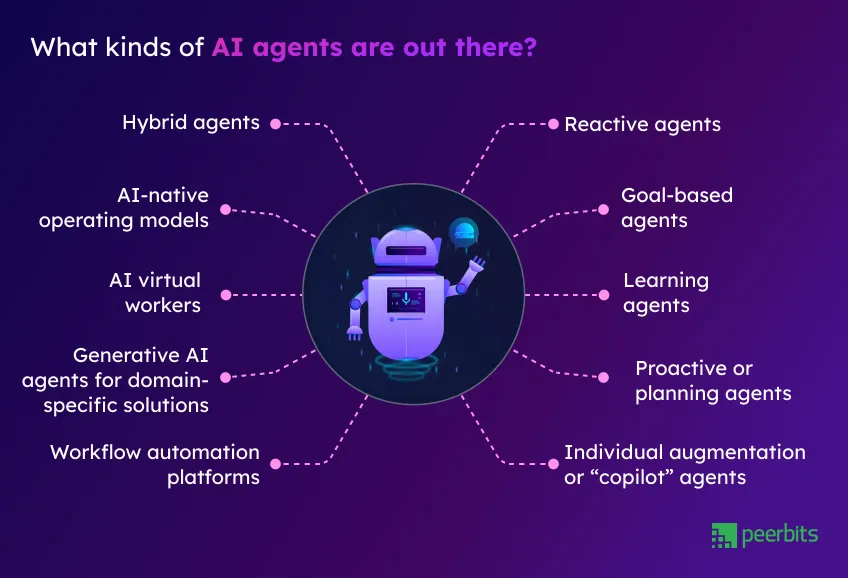
While some AI agents are built for complex reasoning, others stick to simple tasks. Others think a few steps ahead. Most tools today blend different types to get work done smoothly. Here’s a breakdown:
1. Reactive agents
These agents respond to current inputs without using past experiences. They're ideal for simple tasks like answering FAQs or routing tickets where instant reaction matters.
2. Goal-based agents
These work toward a defined outcome. Instead of following fixed instructions, they decide on the next step based on the end goal and the current situation.
3. Learning agents
They improve as they go by analyzing past data and user feedback. This makes them well-suited for evolving tasks such as personalized recommendations or email sorting.
4. Proactive or planning agents
Instead of waiting for input, they anticipate needs and take initiative. These agents can plan tasks ahead of time or remind teams when something requires attention.
5. Individual augmentation or “copilot” agents
These act as real-time assistants to employees. They suggest edits, pull data, or summarize documents to help users work faster without taking over control.
6. Workflow automation platforms
They manage repetitive tasks across systems. These agents pass data between tools, send alerts, and help teams avoid manual coordination or follow-ups.
7. Generative AI agents for domain-specific solutions
These are trained with industry-specific knowledge. Whether it’s legal drafting, medical analysis, or financial reports, with the help of Generative AI development, on can handle niche tasks with better accuracy.
8. AI virtual workers
They operate independently on well-defined tasks like writing replies, generating reports, or updating systems. They reduce the need for manual touchpoints.
9. AI-native operating models
Some businesses are now building operations with AI agents integrated from the beginning. This shifts agents from being side tools to being active parts of daily work.
10. Hybrid agents
These blend traits from reactive, learning, and goal-based agents. They adapt, multitask, and are common in real business tools that run behind the scenes.
Most AI agents in the real world combine different strengths. They learn from data, handle tasks without constant input, and keep work flowing in the background. That’s what makes them so good at solving long-standing business problems.

Real-world example of AI Agents in action
Plenty of companies are already putting AI agents to work in day-to-day operations. Here’s how a global tech player is seeing measurable results across teams.
- Who’s using AI agents?
Lenovo, the multinational technology company, has been actively integrating AI agents into its core operations.
- Where exactly?
Two main areas: Software engineering and customer support.
- What’s the impact on engineering?
Their software teams are using AI agents to speed up development workflows, resulting in up to a 15% improvement in productivity, according to Arthur Hu, CTO of Lenovo’s Solutions and Services Group.
- What’s happening in customer support?
AI agents are assisting with tasks like call triaging, resolution suggestions, and response handling. As a result, the company has seen double-digit gains in call handling efficiency, noted by COO Linda Yao.
Read more: How AI is revolutionizing customer suppory Industry in 2025?
AI agents in 2025: Use cases
You don’t need to change everything at once to start seeing the value. Many businesses are already using AI agents in small but impactful ways that reduce friction and save time.
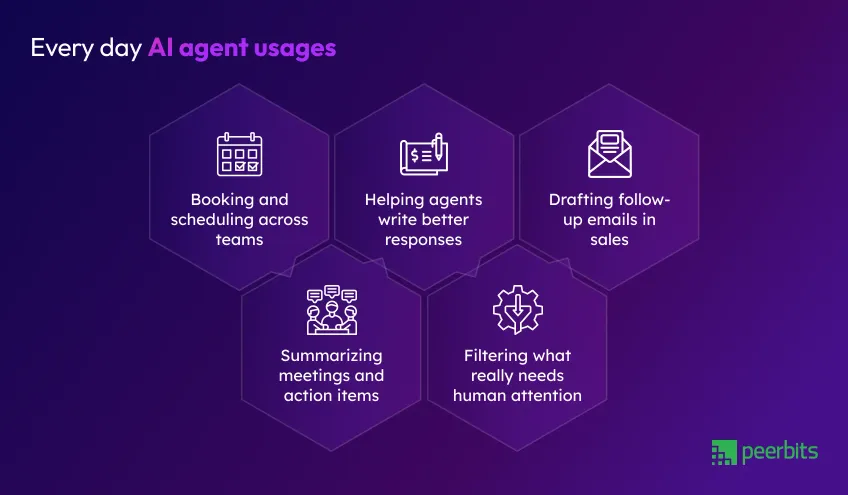
Booking and scheduling across teams
AI agents are handling internal calendar coordination, meeting requests, and reminders so people can stay focused instead of chasing availability.
Helping agents write better responses
Support reps still lead the conversation, but AI agents help them draft replies faster, offer suggestions, and surface helpful resources on the fly.
Drafting follow-up emails in sales
Sales teams use AI agents to create thoughtful, context-aware follow-ups—freeing them up to focus on conversations instead of templates.
Summarizing meetings and action items
From Zoom calls to Slack threads, AI agents are pulling out key points and next steps so nothing gets missed.
Filtering what really needs human attention
Support systems use AI agents to separate routine tickets from the ones that truly need escalation, keeping queues clean and customers happier.
Impact of AI agents on businesses
They help teams stay sharp, make customers feel seen, and keep work flowing without constant hand-holding.
- Fewer workflow delays or backlogs
- Happier customers with faster and smarter responses
- Teams feel less drained from repetitive tasks
- Businesses scale without piling on extra costs
Adopting AI Agents: Key factors to consider
Adopting AI agents doesn’t have to be a daunting process. Before you take the plunge, here’s a simple checklist to help you decide if it’s the right fit for your business:
-
No need for a data science team: Many AI tools are designed for ease of use and don’t require deep technical expertise to implement.
-
Enterprise budgets aren’t necessary: AI solutions have become more affordable and can be scaled to fit businesses of all sizes.
-
Focus on small, specific use cases: It’s best to start with a task or department where AI can quickly deliver value, such as automating basic processes or improving support systems.
-
Start with just one task or department: Don’t overwhelm yourself—begin with a single area, test the results, and scale gradually from there.
This checklist helps ensure that adopting AI agents aligns with your current needs and resources. It's easier than ever to integrate them without massive investments or overhauling your entire business.
Challenges in adopting AI Agents
Even with all the buzz, adopting AI agents isn’t always smooth. Many teams hit friction when it comes to clarity, trust, and AI integration. It’s not just about the tech—it’s about getting teams comfortable with change.
Lack of clarity on use cases: Teams struggle to define where agents can actually help in their workflows.
- Fear of disruption: There's hesitation about changing existing systems or processes that still "work."
- Tool overload: With too many platforms already in place, adding another layer feels like a burden.
- Low trust in output: Some leaders still doubt if AI agents can deliver consistent and accurate results.
- Limited internal expertise: Smaller teams may feel they need specialists to even get started.
How to adopt AI agents?
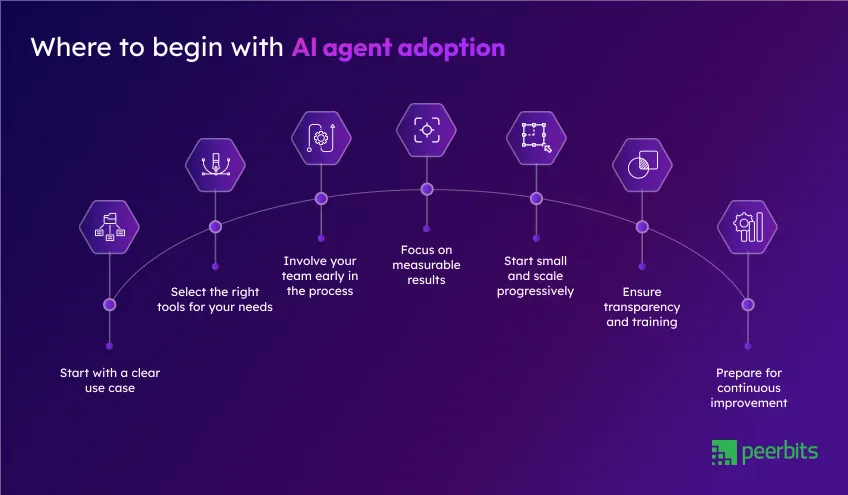
Adopting AI agents is about making strategic moves that are simple yet impactful. Whether it’s improving customer support, automating sales, or boosting internal workflows, AI integration can be approached step-by-step.
Start with a clear use case: Identify areas where AI agents can bring the most value, repetitive tasks like email responses or data entry.
- Select the right tools for your needs: Utilize platforms that already offer AI agent capabilities, such as chatbots, virtual assistants, or workflow automation.
- Involve your team early in the process: The key to smooth adoption is getting your team involved from the start. Their feedback will help shape the process and ensure successful integration.
- Focus on measurable results: Instead of tracking just how many tasks an AI agent completes, measure its impact—whether it's saving time, improving accuracy, or increasing customer satisfaction.
- Start small and scale progressively: Begin with a single department or task, test, learn, and scale gradually. This avoids overwhelming your system and ensures smoother transitions.
- Ensure transparency and training: For smooth adoption, make sure employees understand how AI agents work and how they enhance, not replace, their roles.
- Prepare for continuous improvement: AI agents improve over time. Use feedback and data to constantly refine their performance and capabilities.
Conclusion
AI agents for business are becoming essential for organizations striving to stay competitive. Throughout this blog, we've explored how AI agents work, the different types of agents, and the real-world benefits they bring. From improving operational efficiency and reducing bottlenecks to enhancing customer satisfaction and team well-being, AI agents are transforming businesses in ways we couldn't imagine just a few years ago.
Despite the clear advantages, many businesses still face challenges in adopting AI agents. However, by starting small with focused use cases and scaling over time, companies can mitigate these challenges and unlock the full potential of AI.
AI agents for business provide a strong opportunity to improve your processes, drive innovation, and get ready for the future. The key takeaway: adopting AI agents isn’t a question of "if," but "when."

FAQs
Not at all. AI agents are already being used in healthcare (for patient scheduling), retail (inventory alerts), logistics (route optimization), and finance (fraud detection workflows). It’s less about the industry, more about the workflow needs.
Initially, some oversight is needed to fine-tune performance. But once set up, they operate with minimal human input — alerting you only when things deviate or decisions require review.
They’re more like assistants, not replacements. The goal is to take repetitive tasks off your team’s plate, freeing them up for creative, strategic, or high-impact work.
Yes. Many AI agents now operate in “multi-agent” setups — where one handles intake, another processes logic, and a third takes action. It’s like having a digital team working behind the scenes.


